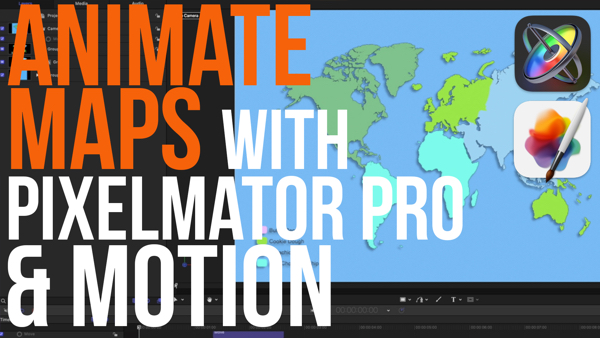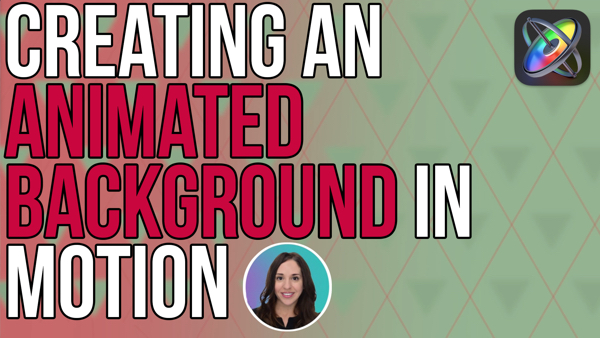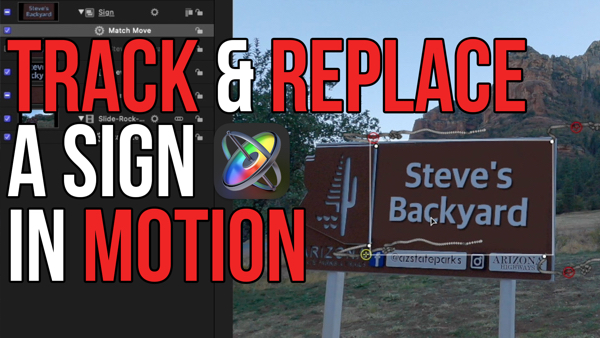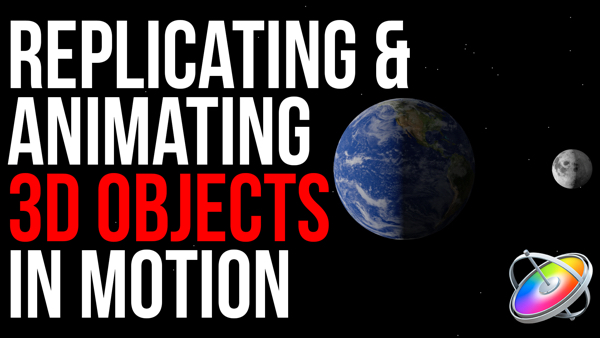Rigging a Shape in Motion 5
In this episode Mark shows you the benefits of jumping into Motion to rig and publish a shape that will not distort the border when using the shape for title or other graphics in Final Cut Pro X.
Welcome to MacBreak Studio, I’m here with Mark Spencer and we’re looking at doing something with shapes. Yeah, I want to give Final Cut Pro X users another reason to consider using Motion for making something useful. Sounds funny, as opposed to making something useless? Well, just some motivation, I make a lot of useless stuff. I just love Motion, I make a lot of fun things, but I just wanted to show something that you can do, that will help you in Final Cut immediately and leverages Motion to do so. Right, great. And here’s the motivation for it. Sometimes you need, when you’re doing an edit, you need a shape. It might be to be a background for a photo, a background for text, but you need some kind of shape on the screen. And Final Cut, in the Generators browser, in the Elements category has a shapes generator. I sometimes forget that’s even there. Some people don’t even know it’s there. So you press E, and I’ll add it to my timeline, then Shift Z to fit it to the window, and Command 4 for the Inspector. Then let’s just close the library list in the browser, we don’t need it. If we look in the inspector, this particular- this is a Motion project. It has some different shapes you can use, and if I got to the square- You know, great, there’s a shape there, and I can increase the width, and I can change the color of the outside. I can do a variety of things to it, but often you want to change the dimensions. Maybe you want it to match 16:9. It’s locked essentially as a square? It kind of is. If you’ll look through the parameters of the generator inspector here, there are not parameters for changing its aspect ratio. So, what you could do is go to the video inspector and use the transform controls for scale. So, if I open up scale and I drag on X, I can make it wider, but look what’s happening. Oh, it’s messing up the border, and making it yucky. Yeah, it’s also scaling the border, so if you didn’t have a border you don’t care. If you just want a white background as a border for a photo or something. But this is a problem. So, I want to show you an easy fix, because what’s going on here is, this shapes generator was built before the new version of Motion, and Motion has changed the way shapes work. And now, you can take advantage of that by making your own shapes for Final Cut. So you’re gonna jump into Motion. Yeah, so I’m gonna jump into Motion. To make shapes, it doesn’t do that? Yeah, we’re done! We’re done here. So, I’m gonna choose a Final Cut generator, but you could do this with a standard Motion project and publish it as a generator. So I’m going to open a new project- I’m sorry, you didn’t open the original one? No, I did not open a copy of the original one. You can’t do it with that- I just wanted to clarify. It’s a really good point, it’s something I mentioned earlier, there might have been an easier way to do what I’m about to do, by just modifying the existing one, but you can’t. You gotta start from scratch. So I have a new Motion project here, I’m gonna hit R for the Rectangle tool, hold the Shift key down, so I get a perfect rectangle. Press Escape, Press F1, Press the Hooked Arrow to center it. Go to the shape inspector right here, add an outline, change the color of the outline. Make sure it’s red like the other one. And I’ll make it red yeah. So here is the cool thing. If I right or Control click on this guy, and choose edit rectangle, we don’t have control points like you might be used to, but we have these other little ways of controlling the shape. That’s new in Motion 5.2? Yeah. And let me guess, you can publish that? Absolutely! Notice what’s happening, that nothing is changing in terms of the width of the outline. If I hold the Option key down while I do this, both of them stretch, and we aren’t changing the width of the outline. So, what’s going on with that- If we go to the inspector here for this guy. If we go to the geometry tab, we can see that we’ve got a roundness slider. That can make it rounder, which you can also control directly here, by dragging the node along the corner. It’s like the mask shape tools in Final Cut Pro X. Yeah, very similar, right. There’s also a size, you’ve got both width and height. That’s what I was doing in the canvas, but you can do it right here in the inspector. And then there is this Control Points, Convert To Points option. So before, all shapes were control points, and once they’re control points, you manipulate them individually, but any scale changes effect the outline and the fill as well. Right. So as long as you don’t convert to points, you have this sort of vector access to controlling the shape. So, I’m basically done. I just created the shape. The question now is, I just want to publish it, and choose what to expose in Final Cut. So certainly, I want to, I’m just going to control click on each of these parameter names, and choose publish. So I’ll publish the roundness. I’ll publish the size, I’m gonna control click on there, publish. And there might be a few other things I’d like to publish.
For instance if we go to the style. Probably the fill color would be worth while. Fill and outline for sure. Yeah, and this is the fun part of just deciding, what do you want to expose to be available to the Final Cut editor. Fill and outline, and maybe you want the outline width to be published as well. Maybe you want the fill opacity to be published? Oh he’s going crazy. Okay, well one more thing. Let’s go to the properties vector, and lets publish the position, and lets publish the rotation. So you can manipulate this in any way you want, pretty much. If I go to the project- You have to select icon- Yes, select the project layer, in the layers list here, and then we go to the project inspector. Here’s our published parameters. And you can test everything right there. I’m going to change the order a little bit. I published the fill opacity in the wrong order, so I’ll just drag that up, and this says brush color- it’s not a brush now. Let’s just call it outline color. So you can see, you can easily rename and reorder published parameters. So, now that we’ve done that, I’ll press Command S, to save. I’ll give it a new category- Before you do that, excuse me, it looks like something go unselected. It’s alright. Maybe I was wrong. I think it’s ok. So, I’m gonna Command S to save, and I’m going to give it a new category, which I’ll call My Shapes. Because you could also create a circle shape as well, or something else. And I don’t care about a theme. And I’ll call this a rectangle, even though it’s a square, because we can make it a rectangle. I don’t need any unused media, there’s no media here at all, and I don’t need previews, so I’ll click publish. You never choose those options. No, I don’t, I don’t. Every single time, I can almost count on you saying, don’t, I never check these. I’m glad they’re unchecked by default. So if I go back to Final Cut now, and in the generators inspector, and there are My Shapes. There’s my rectangle. I’ll press E to append it. Because I’ve published this parameter, I’ll open up scale, and now I can freely adjust X- is that mine that I put in there? Oh no, I don’t want to do scale. You don’t want to transform. I want to generate, that’s very- I’m going like, I don’t see any difference between that and- We were in the video inspector, we want to be in the Generator inspector- I was just testing you. Published parameters, that’s what we want here. So here we have the width and the height. So this is why we want to control here- There- Ahhhh, so now it looks right. Yeah, now it looks right. We’re keeping that width of the outline the same, no matter how wide the overall rectangle. And of course, we can drop the fill opacity down and- All those things that you published- All the things that we published, move the whole thing somewhere else- You published all kinda parameters- All kinda, all kinda, yeah. Because you might need them, depending on what you want to frame, and then you put this blow your video clip, and go fro there. So, maybe in a future episode we’ll talk about an on screen control for that, but I think that’s enough for here. As a way of taking advantage of the new functionality in Motion, to basically update some of the content in Final Cut Pro X. I think that’s excellent. I know, we just basically made a rectangle with an outline on it, but it’s very useful to have these kinds of backgrounds. Yeah, you need that kind of stuff, or then you’d be frustrated trying to get the ones in there to work the way you want them to. Right, excellent. So if you want to really learn Motion and take your knowledge to the next level, we have a whole library. In fact, we’re seeing more and more people learning Motion from our tutorials, just to learn how to do Publishing and make Plug-Ins and stuff. There’s a lot of interest in that right now. He’s got a great tutorial called Rigging and Publishing, you’ll want to check out. Rippletraining.com for these tutorials, Facebook, Twitter, all of the usual places, and we have a great series of Under 5’s, every week on YouTube. And we just want to take the opportunity to thank you for supporting us, and watching us every week. Thanks for watching another episode of MacBreak Studio.
For instance if we go to the style. Probably the fill color would be worth while. Fill and outline for sure. Yeah, and this is the fun part of just deciding, what do you want to expose to be available to the Final Cut editor. Fill and outline, and maybe you want the outline width to be published as well. Maybe you want the fill opacity to be published? Oh he’s going crazy. Okay, well one more thing. Let’s go to the properties vector, and lets publish the position, and lets publish the rotation. So you can manipulate this in any way you want, pretty much. If I go to the project- You have to select icon- Yes, select the project layer, in the layers list here, and then we go to the project inspector. Here’s our published parameters. And you can test everything right there. I’m going to change the order a little bit. I published the fill opacity in the wrong order, so I’ll just drag that up, and this says brush color- it’s not a brush now. Let’s just call it outline color. So you can see, you can easily rename and reorder published parameters. So, now that we’ve done that, I’ll press Command S, to save. I’ll give it a new category- Before you do that, excuse me, it looks like something go unselected. It’s alright. Maybe I was wrong. I think it’s ok. So, I’m gonna Command S to save, and I’m going to give it a new category, which I’ll call My Shapes. Because you could also create a circle shape as well, or something else. And I don’t care about a theme. And I’ll call this a rectangle, even though it’s a square, because we can make it a rectangle. I don’t need any unused media, there’s no media here at all, and I don’t need previews, so I’ll click publish. You never choose those options. No, I don’t, I don’t. Every single time, I can almost count on you saying, don’t, I never check these. I’m glad they’re unchecked by default. So if I go back to Final Cut now, and in the generators inspector, and there are My Shapes. There’s my rectangle. I’ll press E to append it. Because I’ve published this parameter, I’ll open up scale, and now I can freely adjust X- is that mine that I put in there? Oh no, I don’t want to do scale. You don’t want to transform. I want to generate, that’s very- I’m going like, I don’t see any difference between that and- We were in the video inspector, we want to be in the Generator inspector- I was just testing you. Published parameters, that’s what we want here. So here we have the width and the height. So this is why we want to control here- There- Ahhhh, so now it looks right. Yeah, now it looks right. We’re keeping that width of the outline the same, no matter how wide the overall rectangle. And of course, we can drop the fill opacity down and- All those things that you published- All the things that we published, move the whole thing somewhere else- You published all kinda parameters- All kinda, all kinda, yeah. Because you might need them, depending on what you want to frame, and then you put this blow your video clip, and go fro there. So, maybe in a future episode we’ll talk about an on screen control for that, but I think that’s enough for here. As a way of taking advantage of the new functionality in Motion, to basically update some of the content in Final Cut Pro X. I think that’s excellent. I know, we just basically made a rectangle with an outline on it, but it’s very useful to have these kinds of backgrounds. Yeah, you need that kind of stuff, or then you’d be frustrated trying to get the ones in there to work the way you want them to. Right, excellent. So if you want to really learn Motion and take your knowledge to the next level, we have a whole library. In fact, we’re seeing more and more people learning Motion from our tutorials, just to learn how to do Publishing and make Plug-Ins and stuff. There’s a lot of interest in that right now. He’s got a great tutorial called Rigging and Publishing, you’ll want to check out. Rippletraining.com for these tutorials, Facebook, Twitter, all of the usual places, and we have a great series of Under 5’s, every week on YouTube. And we just want to take the opportunity to thank you for supporting us, and watching us every week. Thanks for watching another episode of MacBreak Studio.




